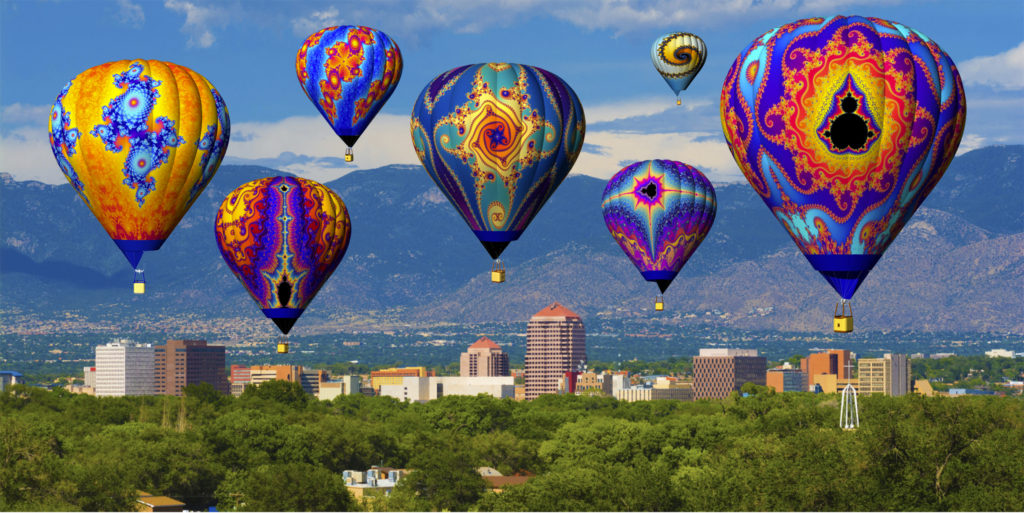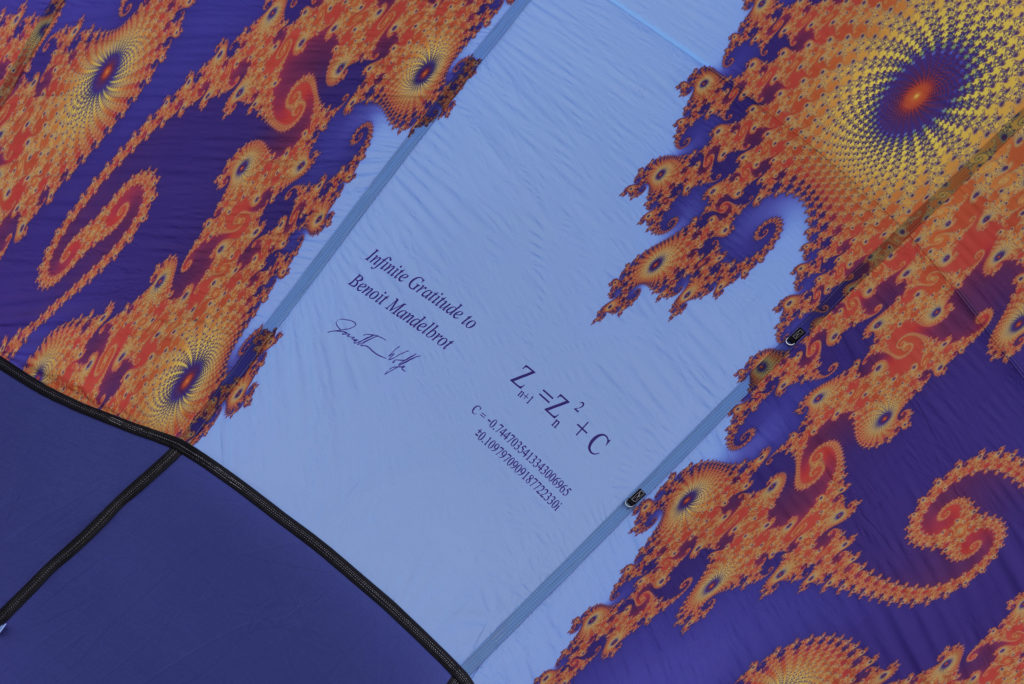
The Fractal Foundation is thrilled to share the beauty of science and math through these incredible Flying Fractal art balloons!
Click the thumbnails above to see images of our Flying Fractals “Infinitude”, “Fibonacci” and future designs.
These are the first balloons ever of their kind, fully digitally printed mathematical artworks. Fractals are infinitely complex patterns that can be zoomed into forever. The images on the balloons are tiny details of the Mandelbrot Set, magnified billions of times. The fractal images consist of hundreds of billions of pixels, with similar details that can be seen from millimeters – or miles away!
These fractal balloons are made possible by advanced dye sublimation printing technology. They are manufactured by our partners Kubicek Balloons in the Czech Republic, and are approved by the FAA as standard certified aircraft.
“Infinitude” is based in Albuquerque, New Mexico, and “Fibonacci” is based in France. Both balloons appear regularly at schools, museums, community events and balloon festivals everywhere, inspiring audiences with the beauty of math and science. To inquire about creating your own fractal art balloon with us, or to invite Infinitude or Fibonacci to your event, please contact jonathan (at) fractalfoundation (dot) org.

At the mouth of “Infinitude” is a dedication to Benoit Mandelbrot (the discoverer of algebraic fractals) as well as the simple formula (Z = Z squared plus C), and the coordinates that generate the image on the balloon. The dedication reads “Infinite Gratitude to Benoit Mandelbrot”. “Infinite Gratitude” was then contracted to “Infinitude” – which became the name of the balloon.
“Fibonacci” was named in honor of the 13th century Italian mathematician and educator who first brought the Hindu-Arabic numeral system to Europe, including the concept of Zero which makes modern arithmetic and algebra possible. The famous Fibonacci Sequence approaches the Golden Ratio, Phi, and is found in many natural fractal patterns (e.g. sunflowers) and which is reflected in the central design motif of the balloon.
Gratitude
The Fractal Foundation also wishes to express our thanks to the family of Jared and Laurie Tarbell for helping bring Infinitude to life!
![]()
And many thanks to Jason Fischer, our long-time supporter and world-wide fractal ambassador, for making Fibonacci possible, and for sharing the inspiring beauty of fractals around the world!
Frequently Asked Questions
- How do you design a fractal balloon?
There are infinitely many fractal patterns to choose from, so the design process is… complex. Working together with the client, we make series of low-res 3D mockups to determine what sorts of possible ideas are pleasing There are some constraints imposed by the 24-gore symmetry of the balloon envelope, so we first explore the design possibilities for 2-fold, 3-fold, 4-fold, 6-fold, 8-fold and 12-fold symmetry. We then look at what types of color schemes are most appealing. Through an iterative design process with the client we hone in on the optimal design, and produce detailed mockups along the way including views from all angles, close-ups, and animations. Once a final design is reached, we start the rendering and post-processing phase, and then ship the files (~100 GB of data) to the manufacturer, Kubicek Balloons for printing and assembly.
- How long does it take to produce a fractal balloon?
Typically, the design process usually takes 1-2 months. Once the design is finalized, it must be rendered at super-high resolution and processed into individual gores and panels, which takes another 1-2 months. After the files are delivered to the Kubicek, the manufacturer, it may take another 2-3 months to produce and deliver the finished product.
- How much does it cost?
The answer varies depending upon some of the details of the balloon system, particularly the volume and the features. The cost is made up of several components: the manufacturing of the envelope, the printing of the fabric, the design of the artwork, and the bottom end, that is the basket, burner, tanks, etc. Very roughly, the cost of a typical plain envelope is about $25,000, the printing cost is about $25,000, the design cost is $15,000, and the bottom end may cost about $20,000, leading to an approximate total cost of $85,000. Contact us with your specific requests, and we can work with the manufacturer to arrange a firm quote.
- Do you work with other Balloon Manufacturers?
At this point, no. Kubicek is the only commercial balloon manufacturer that currently uses polyester fabric, which is required for the high-quality dye-sublimation printing process. We have researched the other manufacturers’ printing solutions, but they have not currently attained the same print quality that we require for the production of fractal art balloons. You can however, use an existing bottom end from a different manufacturer with a fractal printed envelope manufactured by Kubicek.
- Do I need to know about fractals to fly a fractal balloon?
No! The Fractal Foundation will provide you with educational materials, balloon cards, flyers, etc, that you can share with your fans to help them understand what fractals are and how the mathematical art was produced. We are also happy to train our clients to become effective fractal ambassadors who can speak about fractals, but this is not required.
- How do I learn more?
To inquire about creating your own fractal art balloon with us, or to invite Infinitude or Fibonacci to your event, please contact jonathan (at) fractalfoundation (dot) org.

See more pictures and follow our adventures on Instagram @FlyingFractals.
